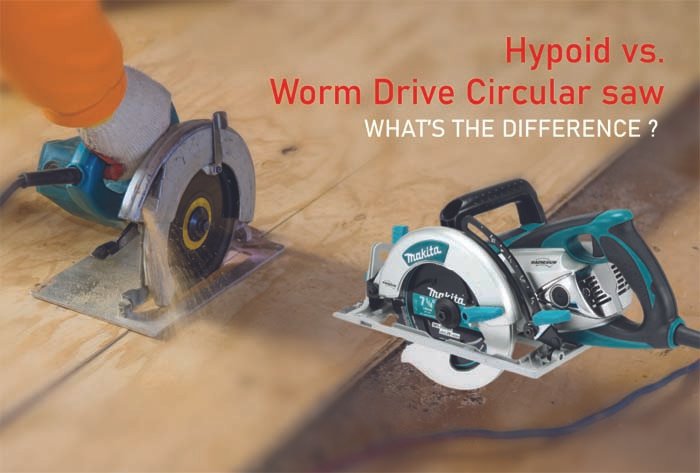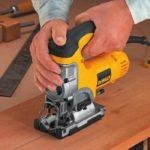When the world is your oyster and time at home, why not build a treehouse? You can depend on Hypoid saws for cutting woodworking projects like roofs without worrying about branches falling on you. Or choose a Worm Drive saw that make quick work of concrete surfaces. Let’s find out more about hypoid vs worm drive circular saw.
There is a big debate when it comes to which saw is better for repairing, a worm drive or hypoid saw. In this blog post, we are going to compare the two and help you decide which one would be better for you.
Both of these saws have their pros and cons, but we will help you weigh those out so that you can make the best decision for your needs. So, if you are looking for the difference between Worm Drive vs Hypoid,
Let’s get started!
What is a Hypoid Saw?
The name “Hypoid” means high-speed and comes from its unique gear structure. Moreover, the axis of these gears is not parallel which allows them to withstand higher speeds than other types with nonparallel angles would in such an instance.
This type is used when torque or RPM needs rise dramatically because it generally provides a 200:1 ratio. Plus, the gear set features an 80%-90% efficiency, which is the best rate for smoothly running your saw.
What is Worm Drive Circular Saw?
A Worm Drive circular saw is a versatile machine and its efficiency can be adjusted with the help of worms, which are metal rings that come in different shapes like circles or square teeth. The best ratio for these types ranges from 49% at 300:1 to 90% at 5:1.
They're used as components on various machines because they provide greater torque than your typical motor provides while still being able to cut through tough material. Plus, the centerline on a worm drive saw is parallel to the plane of the blade, giving it a slim profile that enables users to get into confined spaces.

How Worm Drive Circular Saw works?
Spiral threads on a shaft connect with and propel a toothed wheel in a worm drive saw. Old-fashioned Worm Drive saws are a variation of one of the six basic machines, a gear.
It works by shifting the worm drive saw wheel's location on the worm wheel, it alters the rotational movement by 90 degrees (or simply "the wheel"). A steel worm and a brass wheel are the most common components.
The worm drive saw is powered by an electric motor or engine. As the worm spins against the wheel's teeth, the screw face presses against it. The weight presses the wheel against it.
What Is the Difference Between a Hypoid vs Worm drive circular saw?
Details | Hypoid Saw | Worm Drive Saw |
|---|---|---|
Motor | Sealed Motor | Oil can be changed |
Weight | Weightier | Lightweight |
Blade | Average 12 inches | Average 12 inches |
Power | Average 15 amp | Average 120 Volts |
Cost | Expensive | Less Expensive |
Adjusting for accuracy | 90° and 45° cut | 90° and 45° cut |
Hypoid vs worm drive circular saw – What are the Key Differences?
What makes a circular saw different than Hypoid? The type of blade, shape, and size all play an important role in deciding what kind you need.
Let’s find out the key differences between them:
Motor & Blade Size to Cut Through Efficiently
A 12-inch hypoid saw blade can cut through a wide range of materials. It is also possible to use the 10-inch worm drive blades on a wide range of materials.
Hypoid saws have a sealed motor construction that reduces the expense of maintenance. The motor oil of a worm-drive system, however, may be changed whenever you choose.
Blade Orientation Can Ease the Operation
The majority of worm drive circular saw blades are intended to be used with the left-hand orientation. However, the Hypoid saw is also angled to the left-hand orientation.
Power of the Both Motor
Worming motors are more efficient than hypoid gear systems because they can transmit the same amount of power through a shorter stroke. They work great for contractors who have woodworking operations in confined spaces or environments where there is low visibility.
How the Application Differ
These tools have many similarities. Hypoid saws and worm drive circular saws are both suited for torque-intensive operations, which means that you can cut across any hardwoods or chipboard with any of these tools.
Additionally, the blade is located on one side so it's easy to see where your cuts will go if using this type of power equipment in an enclosed space. And, finally, they're both very effective at handling high performing tasks that require extended weights.
How the Rotation Impact in the Gear System
In a worm drive circular saw, power is transmitted to the blade via an internally geared rotating component called "the Worm." Worm drives are the more popular choice among professionals because they offer greater power and efficiency than hypoid geared saws.
Alternatively, the axes of the mating gears don't meet. A large diameter shaft may be used with this design, thanks to the hypoid gear being offset from the gear center. And, the shaft of a hypoid gear is not aligned with the shaft of the meshing gear.
Operation Process of Both Saw
Hypoid saws are the most efficient form of cutting gear because of their broad pitch surfaces and various contact points. Because of these characteristics, hypoid have higher torque requirements than other kinds of gears, such as sector or spur gears, because they may transmit energy from practically any angle.
On the contrary, Hypoid gears are quieter, while worm-drive saws are better for high-torque applications.
Size and Weight Can Have Great Impact on the Saw
It is inconvenient to use a worm drive saw because of its weight and size. In keeping with the long legacy of SKIL excellence, tough durability, and constant cutting performance, the newest and lightest Worm Drive is here to stay. It weighs only 11.5 lbs., making it the lightest Worm Drive Skilsaw on the market.
Hypoid drive saws, on the other hand, are cumbersome. Nearly 18 pounds is the weight of the most popular Makita hypoid saws.
Do You Have To Maintain Them Regularly?
A Hypoid saw's sealed motor system ensures that you don't have to change the gear oil. However, with a Worm Drive Saw like this one, it is necessary for two reasons. Firstly, during operation, the worm drive releases microscopic metal fragments into your oils which affect overall lubrication.
And secondly, if these micro-metals wear down quickly enough, they could cause leaks in other parts of machinery too! So, be careful in choosing the right machine for your purposes.
Be Safe from Kickback
Saw blade binding or stopping unexpectedly in the wood causes the saw to be propelled back toward the operator, known as "kickback." The Best Worm Drive Circular Saws are designed to prevent kickback by having a handle far back with the saw body. Even if the saw weighs more than 15 pounds, you'll be able to manage it like an experienced professional.
There are parallels to hypoid saw and kickback in this regard. You may still experience some kickback, even though they are resistant to it. You can, however, manage this kickback if you are a pro!
Cost can be a great feature to differ
The hypoid saw cost is a little bit more, it is expensive than the Warm Drive Saw. The cost might be due in part to having two different types of cutting teeth on each side which create an endless piton for better gripping power and stability.
Efficiency of both SAW
Hypoid saws have the best RPM because the blade, gear set, and motor are all positioned at an angle. In terms of effectiveness, it's fairly good (between 80 and 90 percent).
The circular saw uses a worm gear to drive the blade. The circular saw with a worm drive can change its efficiency, which makes it one of a kind. These saws are only 49% efficient at a 300:1 gear ratio, but with a 5:1 gear ratio, they are 90% efficient.
On a final note
Betweenhypoid vs worm drive circular saw, both saws have different situations in mind. If you need more maneuverability and angle cuts or overhead work then SKILSAW is the right choice for your toolkit thanks to its lightweight design which makes it easy on even tired muscles!
It also comes standard with one blade so either left-handed people can use this product without any issue whatsoever.
Hypoid saws have a lot going for them. They’re easy to use and maintain, don't need an oil change or any other regular service work done on them! Plus, their weight makes it perfect if you're working in heavy industries like construction where every inch counts with your tools available today.
If you are looking to make an informed decision between the Worm Drive and Hypoid saws, this comparative article should be of assistance. We hope this article covered the whole comparison.





